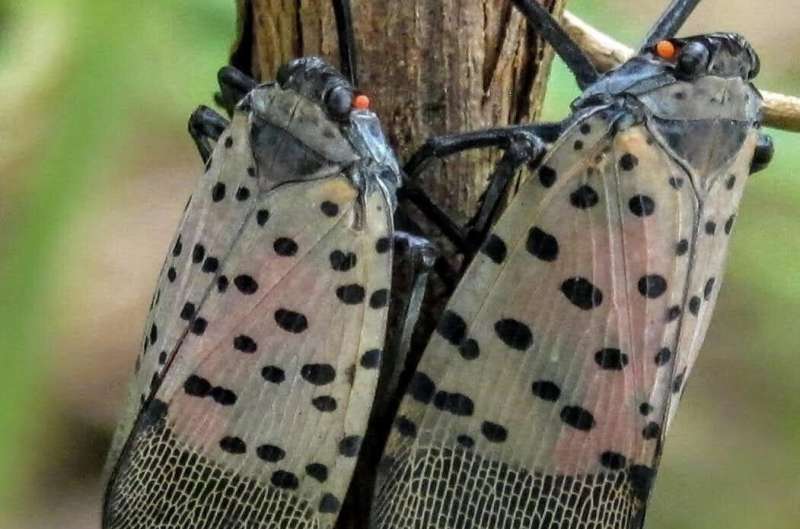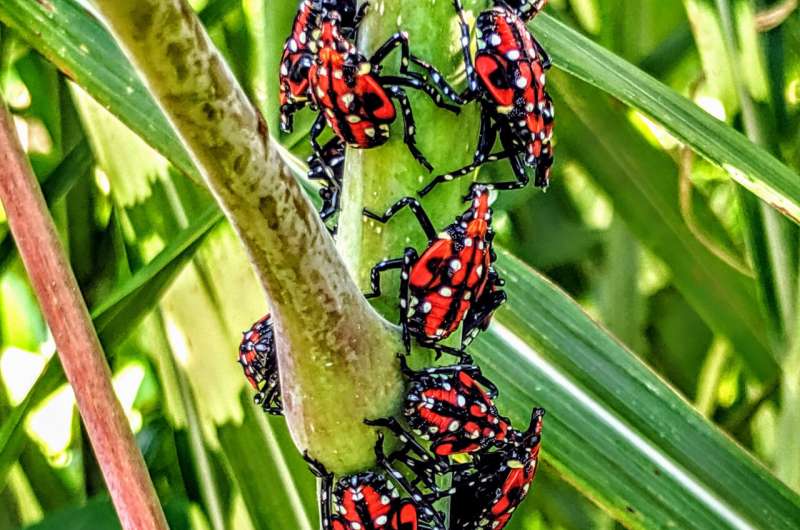This article has been reviewed according to Science X's editorial process and policies. Editors have highlighted the following attributes while ensuring the content's credibility:
fact-checked
peer-reviewed publication
trusted source
proofread
Fighting the spread of the spotted lanternfly with a new data science tool

"Stomp, squash, smash" has been the accompanying soundtrack to the expansion of an odd-looking bug through the Eastern US. The spotted lanternfly, a large planthopper native to Asia, has been popularized in media outlets as the most recent enemy one ought to kill on sight.
This charismatic insect was first discovered in the US in Berks county, Pennsylvania, in 2014, likely the result of an accidental introduction alongside shipments of landscaping materials. Since then, the invasive pest has spread throughout the country, fueled by its ability to hitch rides undetected on cargo and passenger vehicles, and aided by the widespread presence of one of its favorite food sources, the tree of heaven, another invasive in North America. As of 2023, it has been found in 14 US states.
Unfortunately, this species is not picky when it comes to the plants it consumes, favoring both crops and ornamentals, and showing a particular preference for cultivated grape. This dietary choice has impacted several wine-making areas throughout Pennsylvania and New York state, and is threatening important wine hubs on the Western coast of the US.
When it comes to controlling the spread of this pest, two of the main challenges for researchers and field managers alike are to 1) know where this species is today so that eradication campaigns can be targeted and 2) predict where it will be tomorrow, to invest in prevention practices. Both efforts rely on accurate and extensive knowledge of its past and present distribution.
Many state and federal agencies, as well as individual research institutions, have been involved in conducting surveys to detect this bug in the field. In addition, a campaign to raise public awareness has fostered the development of self-reporting tools citizens can use to track sightings of this insect. Unfortunately, given the different practices adopted by these parties, the data on the presence of spotted lanternfly are scattered and hard to access, which makes it harder to assess and manage its spread.

The need to put together a current, comprehensive, consistent and openly available dataset pushed researchers at Temple University to take action.
A research group led by Dr. Matthew Helmus has been closely monitoring the spread of this invasive pest since its inception, contacting institutions and collecting data. In a recent work published on the journal NeoBiota, Dr. Helmus and Dr. Sebastiano De Bona, together with collaborators across several agencies, put together an anonymized and comprehensive dataset that collected all records of spotted lanternfly in the US to date.
These records come from a plethora of sources, from control actions, citizen-science projects, and research efforts. The resulting dataset contains highly detailed data (at 1 km2 resolution) with yearly information on the presence or absence of spotted lanternflies, the establishment status of this pest, and estimated population density, across over 650,000 observations.
"The lydemapr package will aid researchers, managers and the public in their understanding, modeling and managing of the spread of this invasive pest," says Dr. De Bona, the lead author of the study.
The scientists hope that this package will make forecasting the spread of the spotted lanternfly easier and foster more effective collaboration between agencies and researchers.
More information: Sebastiano De Bona et al, lydemapr: an R package to track the spread of the invasive spotted lanternfly (Lycorma delicatula, White 1845) (Hemiptera, Fulgoridae) in the United States, NeoBiota (2023). DOI: 10.3897/neobiota.86.101471
Journal information: NeoBiota
Provided by Pensoft Publishers





















